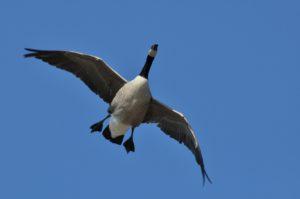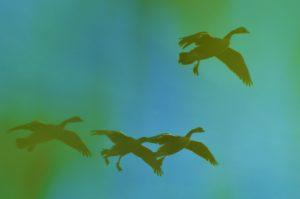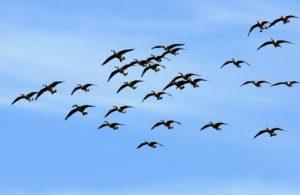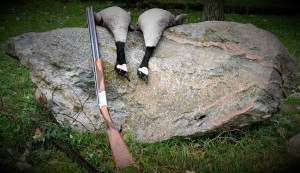Photography courtesy of Lowell Washburn, all rights reserved.
It’s Been An Incredible Goose Season So Far
But I Seriously Doubt That Any Future Hunts Will Be Able To Top
The Canada geese presented a classic example of pure contentment. While some birds preened their feathers, others gossiped among themselves or quietly napped on one leg. To even a casual observer, it was more than a little bit obvious that the mid-day loafers felt completely secure in their surroundings. And why shouldn’t they? Sitting smack in the middle of a cow pasture, the geese were untouchable. Grazed to golf course height for the length of a football field in all directions – the birds were impossible to approach. Sitting near the field’s edge, a single granite boulder was the only object protruding above the grass. Although fall had arrived, the pasture’s grass remained green and succulent; as tasty to hungry geese as it was the cattle foraging nearby.
By now, the Iowa hunting season had been open long enough that geese had learned to avoid hunters and their beguiling spreads of life-like decoys. Spending the daylight hours out in the wide open surrounded by lots of other educated geese was a proven, sure fire tactic for survival.
But were the honkers really as invincible as they appeared? Up until now, the answer had been,” Yes”. The birds were, in a word, untouchable. But as I watched the geese through binoculars, I suddenly had an idea. What would happen if a hunter could somehow be waiting in the middle of that pasture when the geese arrived from their nighttime roost? If that person could manage to become invisible, it could mean a roast goose dinner. On the other hand, if the hunter was detected by the sharp eyed fowl, the outing would become an instant bust.
Getting to the middle of the pasture would be easy. A ten-minute walk would get me to where the geese were currently loafing. Becoming invisible would be the hard part. The pasture’s short cropped, billiard table topography would make a conventional blind stick out like a sore thumb. In order to have the best chance for success, the blind would have to be low. By low I mean flat to the ground. It would also have to be green – as green as grass. But maybe even that matter wouldn’t be as impossible as it seemed.
Returning home, I quickly pruned a couple of thick low hanging branches from a mulberry tree at the edge of the yard. Those leafy branches would become my blind. By daylight the next morning, I was back at the farm. The cows watched with curiosity as I carried my best decoys to the center of the pasture. The cows seemed even more interested when, on my second trip, I added my collection of branches to the spread. After fashioning the foliage into a crude rectangle, I crawled underneath. Rolling my jacket into a pillow, there was nothing to do now but wait. The trap was set.
As the minutes ticked by, the cows finally quit staring and went back to grazing. Lying on my back, I continued to stare at the vacant sky. As the morning sun popped above the horizon, a noisy flock of killdeer suddenly glided in and touched down on the soft grass. The wait continued. Flocks of blackbirds passed overhead, but there were still no geese. Maybe they had decided to loaf somewhere else, I mused. Maybe today’s hunt would turn out to be nothing more than wishful thinking.
And then I heard it. A single, inquisitive honk coming from somewhere in the distance. A few moments later I heard the sound again. This time the notes were louder and were drawing much closer. Peering through the mulberry leaf canopy, I finally spotted the source of the sound – a lone honker approaching the pasture from high in the sky. Arriving over the decoys, I could see the goose turn its head for a better look. Convinced that all was well, the Canada suddenly stalled in midair. Cupping its wings and lowering the unique black-webbed landing gear, the bird appeared to stand on its tail as the vertical decent began. The sight was both dramatic and mesmerizing as the bird continued to plummet. Regardless of what happened from here on out, the single goose had already made the morning effort well worthwhile.
Dropping from the sky on hissing wings, the giant bird was soon within yards. With the goose presenting a chip shot opportunity, it was time to make my move. But before I could rise to take the shot I was surprised, and nearly bowled over, by a flock of five low level geese that had made a totally silent approach to the decoys. Completely distracted by the spectacular sight of that descending loner, I had been unaware of the flock’s presence until they nearly took my hat off. Passing directly overhead the birds were so low that, if I had been standing, I could have literally touched them with my gun barrel. When I finally shouldered the shotgun, I think the geese were as surprised to see me as I had been to see them.
Although the lone Canada – the one that started it all — took off for parts unknown, I did manage to collect my two-goose limit from that low flying flock of five. Walking to the edge of the pasture, I deposited the slain honkers atop the granite boulder. Trading shotgun for camera, I dug in for a second time. The rewards were nearly immediate as the next small band of geese appeared on the horizon. For the next twenty minutes, it was pure chaos as flock after flock of geese arrived and noisily descended to the decoys; the closest landing within a few feet of the flat mulberry leaf blind.
By the time the flight ended, the morning could only be described as somewhere beyond memorable. And while I freely admit to having plenty of waterfowl theories that didn’t pan out in the past, today was not one of them. As crude as it may have been, my low tech tree branch ruse was a success. As happens once in a Blue Moon, the Canada geese had been caught completely flat footed. Although the 2016 Iowa goose season has been incredible so far, I think it will be hard for any future hunts to top the morning I spent with the cows.






 Tom Cope
Tom Cope Sue Wilkinson
Sue Wilkinson Susan Judkins Josten
Susan Judkins Josten Rudi Roeslein
Rudi Roeslein Elyssa McFarland
Elyssa McFarland Mark Langgin
Mark Langgin Adam Janke
Adam Janke Joe Henry
Joe Henry Kristin Ashenbrenner
Kristin Ashenbrenner Joe Wilkinson
Joe Wilkinson Dr. Tammy Mildenstein
Dr. Tammy Mildenstein Sean McMahon
Sean McMahon